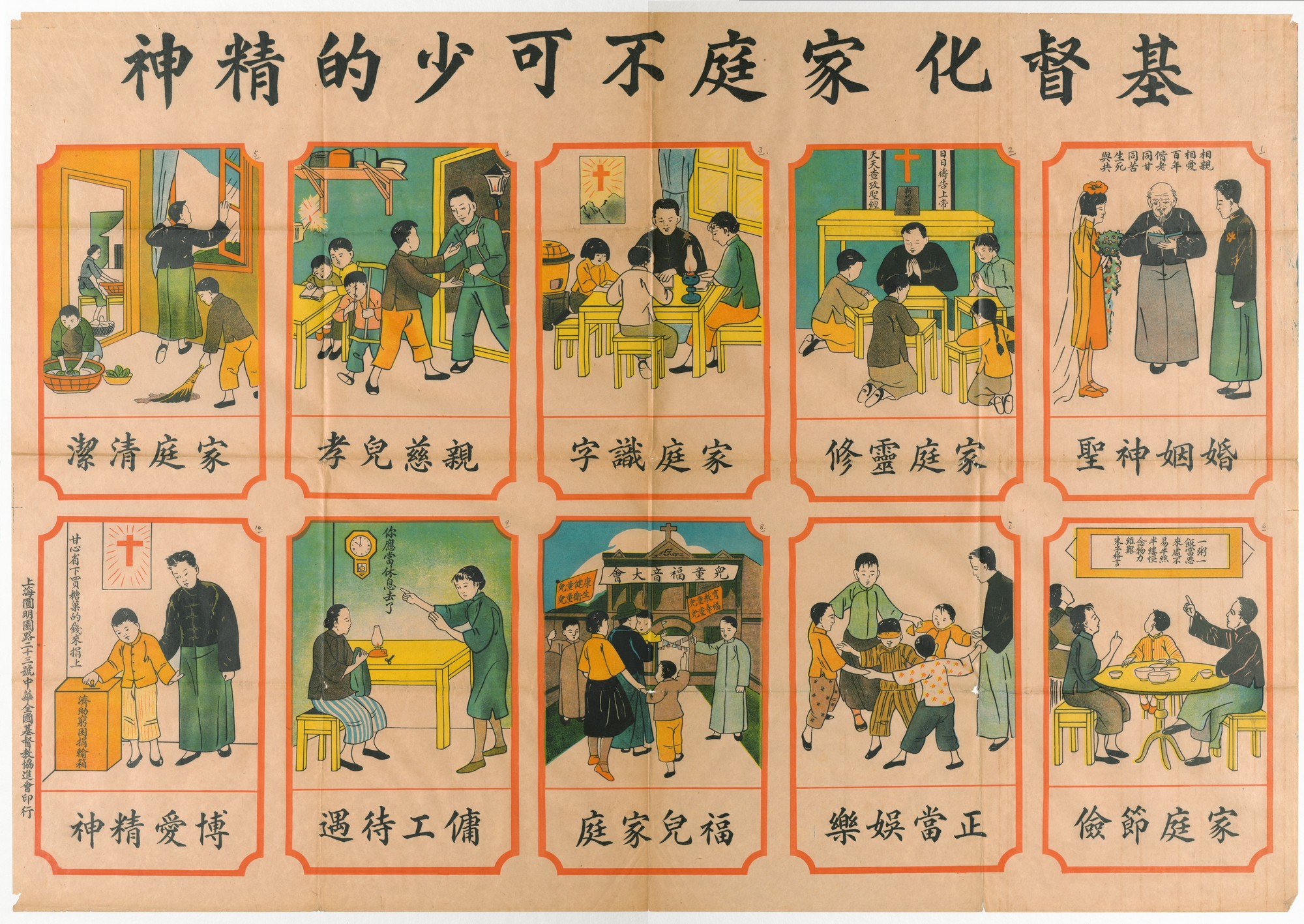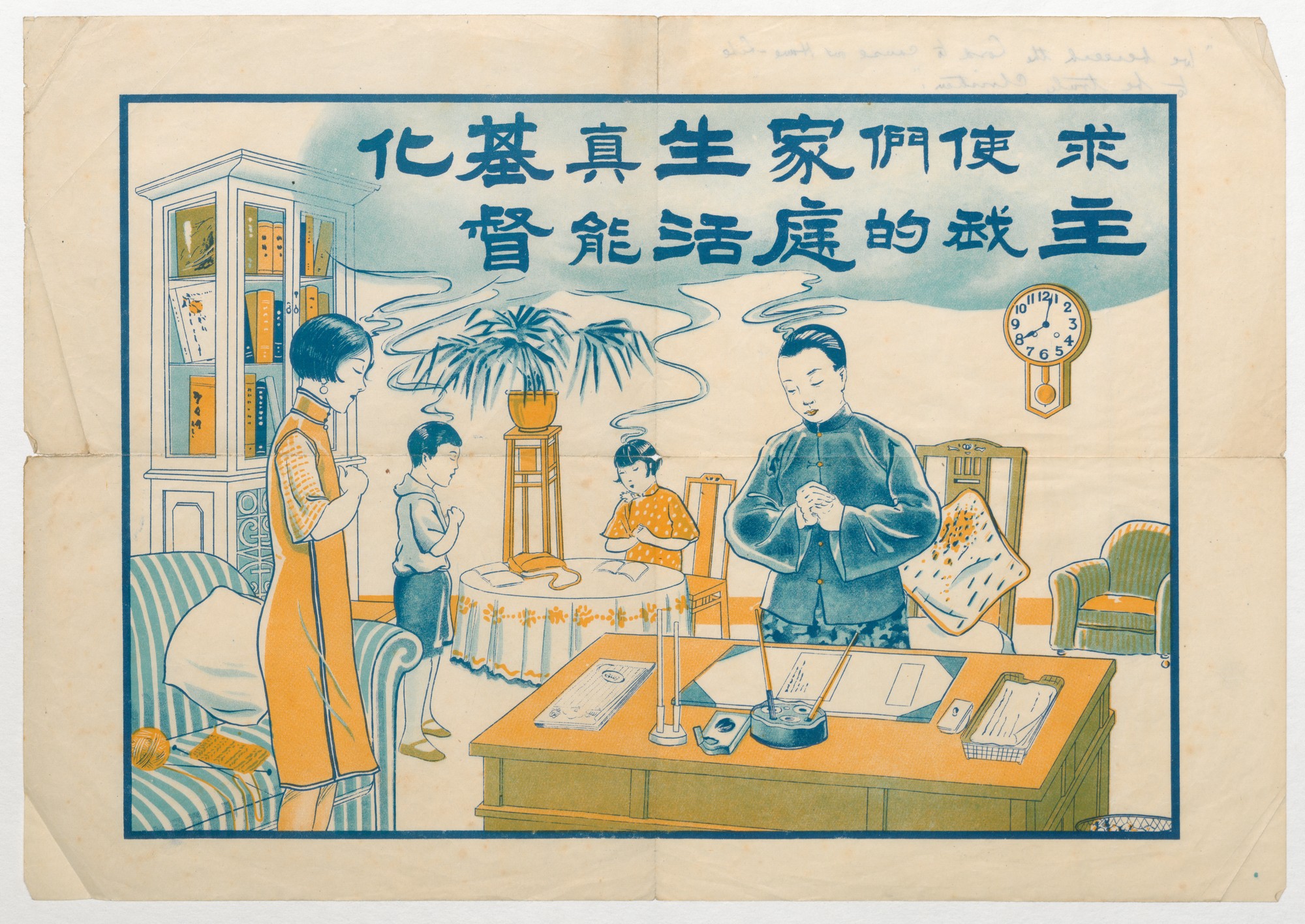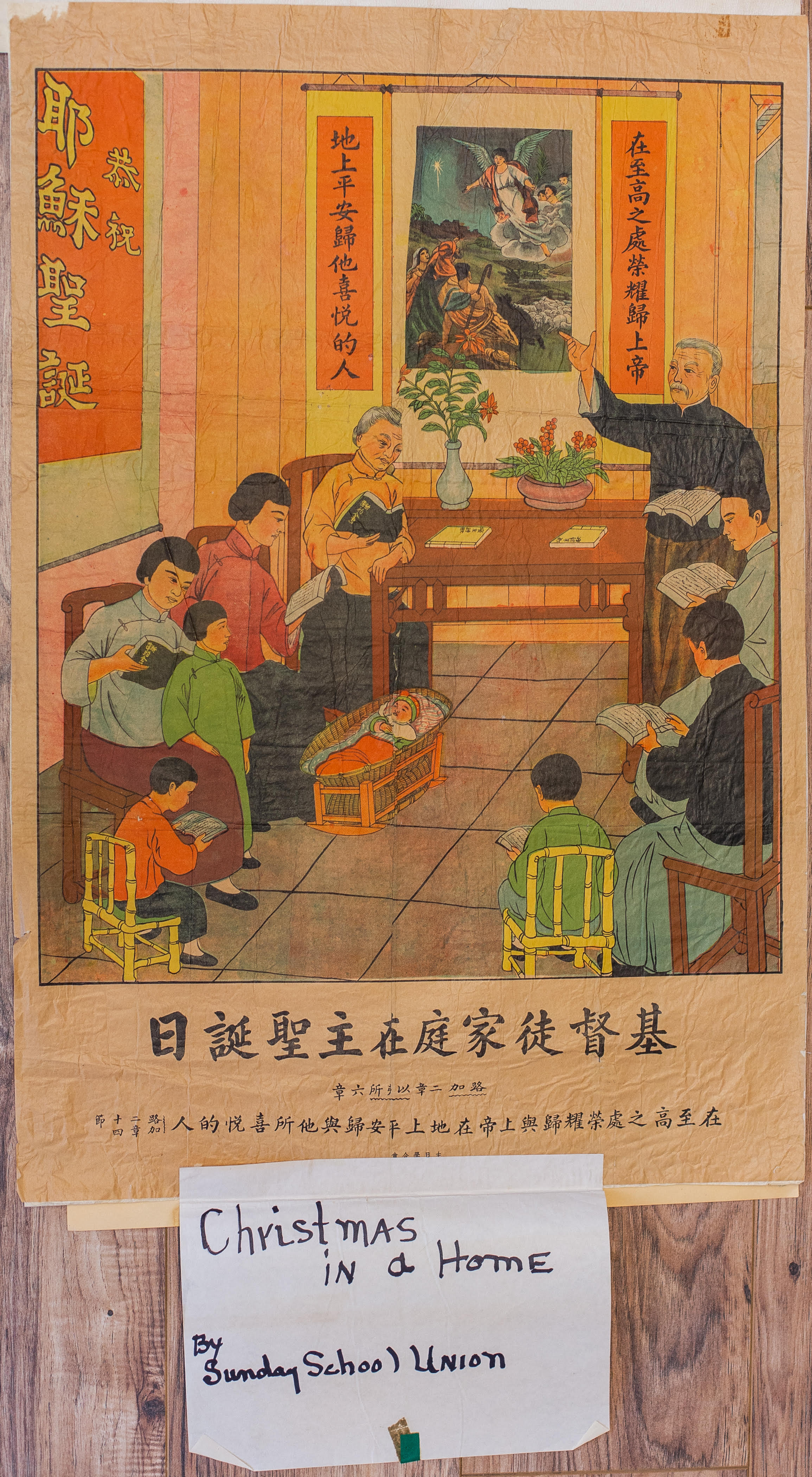With the use of Christian Posters, multiple organizations attempted to Christianize the Chinese families who might be interested in them. In this case, the Christianization of a family is when a Christian group attempts to have the average Chinese family take on values and practices they find more desirable. While Christianization occurred in every place where Christianity spread, it was particularly prominent in China, as there were many values and practices Christian organizations wanted families to do, and some they wanted to change. The posters shown below are some of the ways many Christian organizations try and Christianize families, from changing how families act to changing cultural traditions.
The poster to the right, titled “The Secret of a Christian Family Lies in Behavior,” shows a Chinese family becoming Christianized through their practices. It highlights the idea of filial piety and family. The top left image depicts a family discussing marriage with their child, which represents the role parents often have with their children’s marriage. The discussion in this image says that marriage will be influenced by the partner’s character and personality, implying Christian influence. This poster shows viewers that marriage will be done through love and respect, and for no other reason that could cause a marriage. It is important to know that we see depiction of children playing and respecting their seniors, which is a way to show that many cultural beliefs of the Chinese, such as the reverence one should have towards family, should not change.

We can see similar Christianization in the Nujiang Valley, looking at the Lisu. In chapter 3 of The Songs of Lisu, Arrington says that “The Lisu Christians had already done away with the custom of the bride price, but other matters relating to marriage had yet to be worked out” (Arrington 2020, 72). This excerpt exemplifies how a Christian family uses more Christian beliefs while abandoning their old ones, as the Lisu, and the family seen in this poster, focus less on what marriage could bring oneself and how they used to engage in marriage, and more on what the contemporary, Christian definition of marriage is. This altering of a process that has been done in China for so long represents the Christianization the posters display.
The poster to the right, titled “Indispensable Spirit for Christianizing the Family,” depicts a family acting in different ways a Christian family would. For example, we see a picture in the top right that depicts “holy marriage,” and the words in this picture say that they should love each other, get old together, and die together. The images in this poster show families engaged in entertainment and prayer. In the bottom left of this poster is a depiction of a family donating, showing how one should “help the poor.”

Jonathan Chao, President of the China Ministries International in Taiwan, said, “One of the central features of Chinese culture is the centrality of the family. Within the family there is responsibility and care. In this sense there is a kind of community of love based on family relations. However, that love is graded love based on relations, and hence limited. There is no commitment of love outside the family or the guild or a special association” (Chao 2000, 103). Chao tries to make it clear that outside of the traditional Chinese view of family, the love one has for others is less than if they were Christian. While familial love and respect will continue to stay in the family regardless of religion, as it is fundamentally Chinese, helping others and loving thy neighbor is not as incentivized if a family is not Christian. Thus, the poster above makes it clear that being Christian and Christianizing one’s family would involve not only loving thy family but loving and helping everyone.
The poster to the right, titled “Christianize the Family Song,” describes methods of Christianizing the family in the form of a song. In the song, it says one should be monogamous and love and respect thy wife, children should have filial piety, masters and servants are equal under god, families should have good hygiene, one should love thy neighbor, but most importantly, families need to worship.

In this song, all these tenets are social reforms that many Christian missionaries try and perpetuate in new Christian families. Peter Zarrow, in his chapter “Social Reform: The Role of Christianity,” said that “Many missionary criticisms of Chinese culture were adopted as Chinese self-criticisms. Both Christian and non-Christian elites believed that public morality rested on improving individual private morality” (Zarrow 2023, 51). Zarrow and this poster show that a family does not need to change much in order to Christianize. Even improving private morality, with actions such as filial piety and good hygiene, are ways to do this, and could even improve one’s public morality. These changes are rooted in Christianity as, according to Connie Shemo, the connection between Christianity, health, and hygiene has roots in Western medicine (Shemo 2023, 79).
This poster, titled “Christianize Our Family,” is clear in its intention towards the reader. It shows a family all praying, thinking about god together at one time. The way they pray is by holding their hands together and closing their eyes. The room they pray in is important because of what it lacks – it lacks any idols, or any ancestral tablets. What it does have is the family all thinking at once, and based on the time, before bed. This is similar to what any Christian family across the world would feel and shows that if one were to Christianize a Chinese family, they are no different from any other Christian family.

Jonathan Chao claimed, in his article, “But most importantly, Christian thinking needs to be practiced between husband and wife and in relation to the children, in fact in the way they conduct their lives. Christian values will then be transmitted to the children” (Chao 2000, 101). Arguably the simplest way to Christianize the family is to have them worship together, as stated above. This idea is clearly shown in this poster, with the children all thinking the same prayer as the adult in the room, showing that once the parents Christianize themselves, the children will inevitably follow suit.

In the poster to the left titled “Christmas at Home,” it shows a family that has been Christianized. They are celebrating Christmas, which is an effect of Christianity. Also, instead of an ancestral tablet or idol, there is a painting of an angel revealing itself to people. The nearby banners praise God, showing who the family prays to and how, but still showing facets of traditional Chinese culture in its design and how the family worships together, with the eldest leading the guiding the rest.
Multiple posters above show children engaging in activities and entertainment above. This poster shows them worshipping with their family, which was asserted to be a good method of Christianization. Margaret Mih Tillman made the assertion that by engaging in play, children gain good moral behavior, such as “attending a church drama rather than resorting to alternatives from the non-Christian dominant culture” (Tillman 2023, 97). Looking at this poster, it becomes clear that this family is engaging in Christian festivities and worship rather than any alternative festivals or plays that could be taking place, showing Christianization.
Overall, its clear that Christianizing the family is caused by no single change in culture or tradition, but rather many small and significant changes. This could involve changing how one engages with marriage, ridding one’s household of ancestral tablets, or simply worshipping Jesus and taking care of oneself. These posters showed what it would look like if a Chinese family were to Christianize.
Arrington, Aminta. “The Evangelization of the Nujiang Valley.” Songs of the Lisu Hills: Practicing Christianity in Southwest China. University Park: Penn State University Press, 2020, 65-92.
Chao, Jonathan. “Christianization of Chinese Culture: An Evangelical Approach.” Transformation 17, no. 3, Thousand Oaks: Sage Publications, 2000, 98–104.
Shemo, Connie. “Women: Public Health, Hygiene, and Nurses.” Visions of Salvation: Chinese Christian Posters in an Age of Revolution, ed by Daryl Ireland. Waco: Baylor University Press, 2023, 75-88.
Tillman, Margaret Mih. “Childhood: The Foundation for True Health.” Visions of Salvation: Chinese Christian Posters in an Age of Revolution, ed. by Daryl Ireland. Waco: Baylor University Press, 2023, 89-109.
Zarrow, Peter. “Social Reform: The Role of Christianity.” Visions of Salvation: Chinese Christian Posters in an Age of Revolution, ed. by Daryl Ireland. Waco: Baylor University Press, 2023, 33-51.
